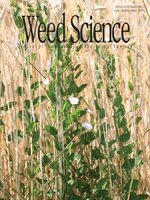The synthetic auxin herbicides, aminocyclopyrachlor and clopyralid, control dicotyledonous weeds in turf. Clippings of turfgrass treated with synthetic auxin herbicides have injured off-target plants exposed to herbicide-laden clippings. Labels of aminocyclopyrachlor and clopyralid recommend that clippings of treated turfgrass remain on the turf following a mowing event. Alternative uses for synthetic auxin-treated turfgrass clippings are needed because large quantities of clippings on the turf surface interfere with the functionality and aesthetics of golf courses, athletic fields, and residential turf. A white clover bioassay was conducted to determine the persistence and bioavailability of aminocyclopyrachlor and clopyralid in turfgrass clippings. Aminocyclopyrachlor and clopyralid were each applied at 79 g ae ha−1 to mature tall fescue at 56, 28, 14, 7, 3.5, and 1.75 d before clipping collection (DBCC). Clippings were collected, and the treated clippings were recycled onto adjacent white clover plots to determine herbicidal persistence and potential for additional weed control. Clippings of tall fescue treated with aminocyclopyrachlor produced a nonlinear regression pattern of response on white clover. Calculated values for 50% response (GR50) for visual control, for normalized difference vegetative index (NDVI), and for reduction in harvested biomass were 20.5, 17.3, and 18.7 DBCC, respectively, 8 wk after clippings were applied. Clippings of tall fescue treated with clopyralid did not demonstrate a significant pattern for white clover control, presumably because clopyralid was applied at a less-than-label rate. The persistence and bioavailability of synthetic auxin herbicides in clippings harvested from previously treated turfgrass creates the opportunity to recycle clippings for additional weed control.
Nomenclature: Aminocyclopyrachlor; clopyralid; tall fescue, Lolium arundinaceum (Schreb.) S.J. Darbyshire; white clover, Trifolium repens L. ‘Dutch’.





